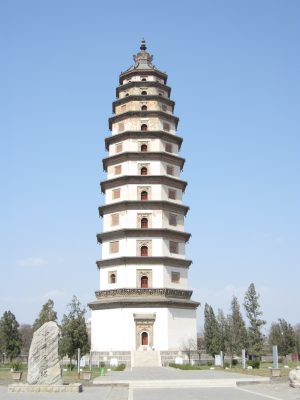The Song Dynasty (960-1279 AD) was a period of Chinese history marked by technological advances, economic reforms, artistic achievements, and architectural feats. The Song period saw the construction of some of China’s most iconic structures, including lofty pagodas, impressive temples, large bridges, and ornate tombs.
Overview of the Architect Profession
Although not seen as a high profession comparable to the scholar-official, being an architect began to gain more recognition in Song Dynasty China. This was due in part to the increasing number of large-scale building projects that were undertaken during this period. Architects were responsible for designing and supervising the construction of palaces, temples, government offices, and other public works.
Traditionally, architectural knowledge was orally passed down from father to son (or apprentice). However, a few written texts on architecture began to circulate during the Song Dynasty. These texts helped to codify the architectural practices of the time and allowed for greater standardization in building projects. Literary works on architecture already existed before the Song Dynasty, but during this period, the literature began to mature into a more professional form.
Architectural writers of the time included more detailed descriptions of dimensions and working materials in their texts. Some published works even had architectural drawings and illustrations.
Types of Architecture in the Song Dynasty
1) Buddhist Pagodas
Pagodas were among the most iconic structures of the Song Dynasty. These tall, multi-story towers were built to house Buddhist relics or serve as memorials for important figures. Architects in the Song Dynasty built most Buddhist pagodas out of stone, which contrasted with how the Han Dynasty (the period where pagodas were first constructed in China) built their pagodas—with wood. However, to make pagodas more ornate, architects often added intricate wooden lattices around the exterior. Spires were also a common feature of Buddhist pagodas. The Song Dynasty saw the construction of some of China’s tallest pagodas. Some examples are:
Liaodi Pagoda
Built in 1055, the Liaodi Pagoda is located at Kaiyuan Monastery in Dingzhou. It is the tallest pre-modern Chinese pagoda that still exists today and is the tallest brick pagoda in the world.
Beisi Pagoda
Built in 1161, the Beisi Pagoda (or North Temple Pagoda) is located at Bao’en Temple in Suzhou. It is a nine-story (formerly eleven-story) octagonal pagoda that stands at 249 ft.
2) Temples
Temple complexes were designed for worship, housing monks, and other religious purposes. Wealthy families often donated land as a form of religious merit. Some of these lands already had buildings on them that were renovated to be used as temples. These donations resulted in the construction of many new temples and the expansion of existing ones.
The size of temples varied greatly depending on their purpose and location. Some were small buildings, while others consisted of large courtyards and multiple halls. The layout of a temple was often symmetrical, with the main hall (or halls) located in the center and smaller structures placed on either side.
Shengmu Hall
Also known as the Holy Mother Hall or Saintly Mother Hall, Shengmu Hall is the main building of the Jinci Temple in Shanxi. It was first built around 1023 but renovated in 1102. The hall has a double-eaved roof with nine ridges and two dragon-heads at the ends of the main ridge. The eaves curve slightly heavenward at each end, a characteristic of Song Dynasty architecture.
Trinity Hall
The Taoist Trinity Hall is the main hall of Xuan Miao Temple in Suzhou. The hall is a three-bay building constructed out of brick and wood. It has a gable and hip roof and numerous eaves. The roof has caesious tiles, a type of roofing material popular in the Song Dynasty.
3) Bridges
The period also saw the construction of many bridges and canals. These engineering feats helped to improve transportation and communication throughout China.
Ba Zi Bridge
The Ba Zi Bridge is a stone arch bridge located in Shaoxing, Zhejiang. It was built in 1256 and is still standing today. Currently, it is recognized as a national historical and cultural site in the province of Zhejiang by the State Council.
Luoyang Bridge
The Luoyang Bridge used to be called the Wan’an Bridge. Wan’an meant “ten-thousand years of peace,” and the name was chosen to say that it would be safe to cross the bridge and stand for a long time. The bridge is located near Quanzhou in Fujian province. It was constructed from stone and is known as China’s first seaport bridge.
4) Tombs
Many tombs for members of the imperial family and other important figures were built during the Song Dynasty. These tombs were designed to be grandiose and located in scenic areas.
The Eight Mausoleums of Seven Emperors
The Eight Mausoleums of Seven Emperors were located in Gongxian County, 130 km from the capital at Kaifeng, during the Northern Song Dynasty. This area was chosen because of its beautiful scenery and good soil texture. These mausoleums had spirit ways lined with statues of animals, mythical creatures, military generals, government officials, and other Song sculptures.
The Baisha Tomb
The Baisha Tomb of the Southern Song Dynasty is located in the province of Henan. It contains two separate chambers with conical domed ceilings. The tomb was built with carved bricks and decorated with murals, intending to imitate wooden buildings.
Conclusion
Despite being over 1000 years old, many Song Dynasty structures are still standing today and remain popular tourist destinations. The vast amount of architectural diversity within the dynasty is a reflection of the sophistication of Song culture. In contrast to the uniformity found in the architecture of later dynasties, the Song Dynasty was a period of experimentation, with new styles being developed.
